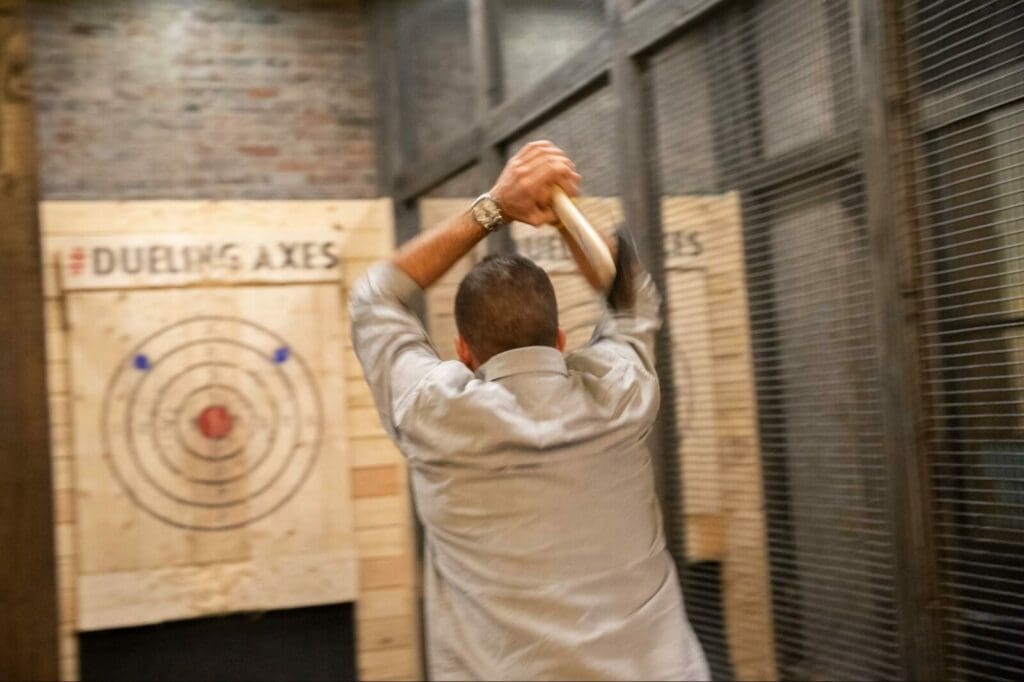Step Up Your Game with Axe Throwing Denver: Master Your Skills Today
Step Up Your Game with Axe Throwing Denver: Master Your Skills Today
Blog Article
The Enjoyable of Axe Throwing: How This Sporting Activity Integrates Ability and Adrenaline for a Good Time
Axe throwing has emerged as a captivating sporting activity that masterfully links the demand for specific skill with the rush of adrenaline, offering participants a engaging and one-of-a-kind experience. The act of tossing an axe in the direction of a target demands concentration and method, simultaneously promoting an atmosphere of camaraderie and pleasant competition. This appealing blend of mental emphasis and physical effort has made axe tossing a popular option for those seeking both recreation and a feeling of success. To truly appreciate the deepness and appeal of this task, one have to consider its beginnings, the needed devices, and the fundamental strategies that make sure both safety and security and enjoyment.
The Beginnings of Axe Throwing
Axe throwing, a recreational activity that has actually gotten considerable appeal in current years, traces its origins back to old times. This primal sport days back to early human history, when axes were mostly made use of as tools and weapons. The earliest records of axe usage in competitive contexts are found among the Celts and Vikings, that tossed axes for sport as well as in combat training. The technique was not simply a leisure activity but a vital skill for survival and war.
Middle ages European warriors, particularly throughout the Center Ages, exercised axe throwing as part of their martial training. The Francisca, a sort of throwing axe used by the Franks, came to be renowned for its harmful precision. This traditional tool was created to be thrown at opponent shields and shield, showcasing its twin energy in both sporting activity and fight.
In more recent background, axe throwing saw a rebirth in the logging camps of North America in the 19th and 20th centuries. Lumberjacks would certainly involve in pleasant competition, examining their precision and stamina by targeting at wooden targets. This evolution from a survival skill to a recreational activity has led the way for its modern-day resurgence, with devoted locations and leagues now celebrating the sporting activity internationally.
Tools You Required
Comprehending the rich history of axe throwing enhances the appreciation of the sporting activity's modern-day version. Central to this thrilling task is the tools, which is necessary for both security and efficiency. The key device is, naturally, the axe. For leisure and competitive axe throwing, the most commonly made use of kind is the hatchet, usually considering between 1.25 to 2 pounds with a deal with size of around 16 inches. The axe ought to have a sharp, well-kept blade and a take care of made from sturdy wood or composite product, making certain an excellent grip and balance.
Just as crucial is the target. Policy targets are constructed from timber, with softwood selections like ache or cottonwood being favored for their capacity to hold the axe and take in. The target is normally split right into 5 concentric circles, each with a certain point worth, to help with rating.
Security equipment, however commonly overlooked, is critical. Safety gloves can improve hold and prevent sores, while closed-toed shoes are a must to secure feet from gone down axes (denver axe throwing). Finally, a well-lit, large tossing location, complete with security barriers, makes certain a regulated setting where participants can concentrate on honing their skills.
Basic Techniques Clarified
Understanding the fundamental strategies of axe throwing is crucial for both safety and security and proficiency. The very first technique to comprehend is the hold. Hold the axe with a firm, yet kicked back grip, similar to holding a golf club. The leading hand should be positioned directly below the axe head, while the non-dominant hand supports completion of the deal with.
Next, focus on the stance. Stand with your feet shoulder-width apart, ensuring your body is balanced. Your leading foot ought to be somewhat forward, aligning with your target. This positioning help in keeping security and routing power properly towards the target.

Security First
Making sure safety and security in axe throwing is critical to producing a delightful and injury-free experience. A well-designed axe tossing center attributes clear separations between tossing lanes, durable backgrounds check out this site to catch roaming axes, and non-slip floor covering to protect against crashes.
Benefits of Axe Throwing
Axe tossing offers a myriad of advantages that prolong beyond easy recreation. The recurring movement of throwing the axe additionally enhances hand-eye control and fine motor skills.
Mentally, axe tossing calls for focus, precision, and technique, making it a superb way to develop cognitive skills. The focus required to hit the target can act as a type of mindfulness, permitting individuals to remove their minds and minimize tension. This psychological involvement can be particularly useful in helping individuals establish better problem-solving abilities and psychological durability.
Socially, axe throwing is frequently appreciated in group settings, fostering team-building and camaraderie. Whether as component of a business occasion or a laid-back outing with good friends, the sport encourages interaction and collaboration. In addition, the public experience of learning and improving with each other can reinforce partnerships and develop enduring memories.
Verdict

The earliest documents of axe usage in affordable contexts are discovered among the Celts and Vikings, who threw axes for sporting activity as well as in fight training. Launch the axe when your hands are approximately at eye degree, allowing the axe's natural turning to direct it towards the target.
A properly designed axe throwing center features clear demarcations in between tossing lanes, strong backgrounds to capture stray axes, and non-slip flooring to stop mishaps. Participants must be advised on the right method to toss the axe and take care of, highlighting regulated, purposeful motions over powerful throws.
In summary, axe throwing stands out as a sporting activity that masterfully integrates ability, precision, and adrenaline.
Report this page